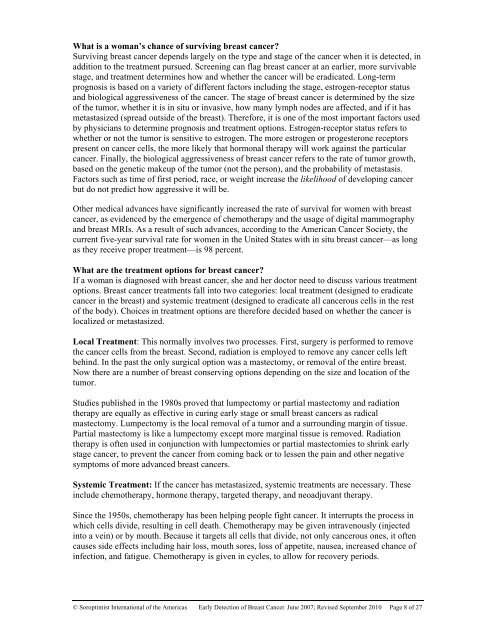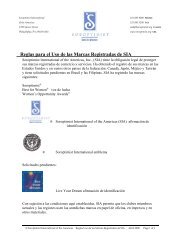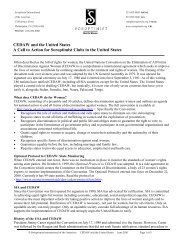Early Detection of Breast Cancer - Soroptimist
Early Detection of Breast Cancer - Soroptimist
Early Detection of Breast Cancer - Soroptimist
You also want an ePaper? Increase the reach of your titles
YUMPU automatically turns print PDFs into web optimized ePapers that Google loves.
What is a woman’s chance <strong>of</strong> surviving breast cancer?<br />
Surviving breast cancer depends largely on the type and stage <strong>of</strong> the cancer when it is detected, in<br />
addition to the treatment pursued. Screening can flag breast cancer at an earlier, more survivable<br />
stage, and treatment determines how and whether the cancer will be eradicated. Long-term<br />
prognosis is based on a variety <strong>of</strong> different factors including the stage, estrogen-receptor status<br />
and biological aggressiveness <strong>of</strong> the cancer. The stage <strong>of</strong> breast cancer is determined by the size<br />
<strong>of</strong> the tumor, whether it is in situ or invasive, how many lymph nodes are affected, and if it has<br />
metastasized (spread outside <strong>of</strong> the breast). Therefore, it is one <strong>of</strong> the most important factors used<br />
by physicians to determine prognosis and treatment options. Estrogen-receptor status refers to<br />
whether or not the tumor is sensitive to estrogen. The more estrogen or progesterone receptors<br />
present on cancer cells, the more likely that hormonal therapy will work against the particular<br />
cancer. Finally, the biological aggressiveness <strong>of</strong> breast cancer refers to the rate <strong>of</strong> tumor growth,<br />
based on the genetic makeup <strong>of</strong> the tumor (not the person), and the probability <strong>of</strong> metastasis.<br />
Factors such as time <strong>of</strong> first period, race, or weight increase the likelihood <strong>of</strong> developing cancer<br />
but do not predict how aggressive it will be.<br />
Other medical advances have significantly increased the rate <strong>of</strong> survival for women with breast<br />
cancer, as evidenced by the emergence <strong>of</strong> chemotherapy and the usage <strong>of</strong> digital mammography<br />
and breast MRIs. As a result <strong>of</strong> such advances, according to the American <strong>Cancer</strong> Society, the<br />
current five-year survival rate for women in the United States with in situ breast cancer—as long<br />
as they receive proper treatment—is 98 percent.<br />
What are the treatment options for breast cancer?<br />
If a woman is diagnosed with breast cancer, she and her doctor need to discuss various treatment<br />
options. <strong>Breast</strong> cancer treatments fall into two categories: local treatment (designed to eradicate<br />
cancer in the breast) and systemic treatment (designed to eradicate all cancerous cells in the rest<br />
<strong>of</strong> the body). Choices in treatment options are therefore decided based on whether the cancer is<br />
localized or metastasized.<br />
Local Treatment: This normally involves two processes. First, surgery is performed to remove<br />
the cancer cells from the breast. Second, radiation is employed to remove any cancer cells left<br />
behind. In the past the only surgical option was a mastectomy, or removal <strong>of</strong> the entire breast.<br />
Now there are a number <strong>of</strong> breast conserving options depending on the size and location <strong>of</strong> the<br />
tumor.<br />
Studies published in the 1980s proved that lumpectomy or partial mastectomy and radiation<br />
therapy are equally as effective in curing early stage or small breast cancers as radical<br />
mastectomy. Lumpectomy is the local removal <strong>of</strong> a tumor and a surrounding margin <strong>of</strong> tissue.<br />
Partial mastectomy is like a lumpectomy except more marginal tissue is removed. Radiation<br />
therapy is <strong>of</strong>ten used in conjunction with lumpectomies or partial mastectomies to shrink early<br />
stage cancer, to prevent the cancer from coming back or to lessen the pain and other negative<br />
symptoms <strong>of</strong> more advanced breast cancers.<br />
Systemic Treatment: If the cancer has metastasized, systemic treatments are necessary. These<br />
include chemotherapy, hormone therapy, targeted therapy, and neoadjuvant therapy.<br />
Since the 1950s, chemotherapy has been helping people fight cancer. It interrupts the process in<br />
which cells divide, resulting in cell death. Chemotherapy may be given intravenously (injected<br />
into a vein) or by mouth. Because it targets all cells that divide, not only cancerous ones, it <strong>of</strong>ten<br />
causes side effects including hair loss, mouth sores, loss <strong>of</strong> appetite, nausea, increased chance <strong>of</strong><br />
infection, and fatigue. Chemotherapy is given in cycles, to allow for recovery periods.<br />
© <strong>Soroptimist</strong> International <strong>of</strong> the Americas <strong>Early</strong> <strong>Detection</strong> <strong>of</strong> <strong>Breast</strong> <strong>Cancer</strong> June 2007; Revised September 2010 Page 8 <strong>of</strong> 27
















